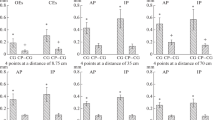We studied the effects of unexpected shifts of the visually perceived artificial surroundings (virtual visual environment, VVE) on postural reactions evoked by vibrational stimulation of proprioceptors of the shin muscles; tests were performed in a standing position of the subject. The VVE possessed two planes, a mobile foreground, whose displacements correlated with oscillations of the body, and a stationary background. The subjects were asked to use the latter as a reference system in corrections of the posture. The VVE parameters were controlled by a computer; shifts of the VVE foreground were combined with similar, in their duration and profile, stimulation-evoked displacements of the body. Despite the fact that the subjects had a possibility to use the stationary background as the reference system, the magnitudes of the evoked postural responses under conditions of perception of the VVE significantly exceeded the respective magnitudes upon standing with the eyes open in front of a completely stationary visual image. Postural responses progressively increased with increases in relative values of the shifts of the VVE foreground but always remained smaller than the responses under conditions of testing with the eyes closed. Augmentation of the postural responses at a synphase pattern of interrelations between the body movements and VVE shifts was more significant than at antiphase relations. Thus, shifts of the VVE foreground, on the one hand, destabilized the maintenance of the vertical posture, which resulted in intensification of the postural responses. On the other hand, such shifts allowed the subject to use them as feedback signals and to modulate the magnitude of postural responses when there was a change in the direction of interrelations between the body movements and the perceived visual image.
Similar content being viewed by others
References
A. M. Bronstein, J. D. Hood, M. A. Gresty, and C. Panagi, “Visual control of balance in cerebellar and parkinsonian syndromes,” Brain, 113, No. 3, 767-779 (1990).
T. Mergner, G. Schweigart, C. Maurer, and A. Blumle, “Human postural responses to motion of real and virtual visual environments under different support base conditions,” Exp. Brain Res., 167, No. 3, 535-556 (2005).
J. F. Soechting and A. Berthoz, “Dynamic role of vision in the control of posture in man,” Exp. Brain Res., 36, No. 3, 551-561 (1979).
B. N. Smetanin, K. E. Popov, V. S. Gurfinkel, and V. Y. Shlykov, “Effect of movement and illusion of movement on human vestibulomotor response,” Neurophysiology, 20, No. 2, 192-198 (1988).
B. N. Smetanin, K. E. Popov, and G. V. Kozhina, “Human postural responses to vibratory stimulation of calf muscles under conditions of visual inversion,” Human Physiol., 28, No. 5, 556-560 (2002).
S. V. Klimenko, I. N. Nikitin, and L. D. Nikitina, Avango. A System of Development of Visual Surroundings [in Russian], Publ. House of the IPhTI, Moscow, Protvino (2006).
G. Burdea and P. Coiffet, Vertual Reality Technology, John Wiley & Sons, Inc., New York (1994).
E. V. Gurfinkel, “Physical foundations of stabilography,” Agressologie, 14, No. 100, 9-13 (1973).
H. C. Diener, F. B. Horak, and L. M. Nashner, “Influence of stimulus parameters on human postural responses,” J. Neurophysiol., 59, No. 6, 1888-1905 (1988).
J. T. Inglis and J. M. Macpherson, “Bilateral labyrinthectomy in the cat: effects on postural response to translation,” J. Neurophysiol., 73, No. 3, 1181-1191 (1995).
C. F. Runge, C. L. Shupert, F. B. Horak, and F. E. Zajac, “Role of vestibular information in initiation of rapid postural responses,” Exp. Brain Res., 122, No. 4, 403-412 (1998).
J. Fung and L. Hughey, “Postural responses triggered by multidirectional leg litfs and surface tilts,” Exp. Brain Res., 165, No. 2, 152-166 (2005).
J. Fung and J. M. Macpherson, “Attributes of quiet stance in the chronic spinal cat,” J. Neurophysiol., 82, No. 6, 3056-3065 (1999).
J. M. Macpherson and J. Fung, “Weight support and balance during stance in the chronic spinal cat,” J. Neurophysiol., 82, No. 6, 3066-3081 (1999).
F. B. Horak and J. M. Macpherson, “Postural orientation and equilibrium,” in: Handbook of Physiology, Sec. 12, Integration of Motor, Circulatory, Respiratory and Metabolic Control during Exercises, Oxford Univ. Press, New York (1996), pp. 22-46.
T. Mergner, W. Huber, and W. Becker, “Vestibular-neck interaction and transformation of sensory coordinates,” J. Vestib. Res., 7, No. 4, 347-367 (1997).
L. Nashner and A. Berthoz, “Visual contribution to rapid motor responses during postural control,” Brain Res., 150, No. 2, 403-407 (1978).
R. Fitzpatrick and D. McCloskey, “Proprioceptive, visual and vestibular thresholds for the perception of sway during standing in humans,” J. Physiol., 478, Part 1, 173-186 (1994).
P. P. Vidal and A. Berthoz, “Millanvoye M: Difference between eye closure and visual stabilization in the control of posture in man,” Aviat. Space Environ. Med., 53, No. 2, 166-170 (1982).
E. A. Keshner, R. V. Kenyon, and J. Langston, “Postural responses exhibit multisensory dependencies with discordant visual and support surface motion,” J. Vestib. Res., 14, No. 4, 307-319 (2004).
J. W. Streepey, R. V. Kenyon, and E. A. Keshner, “Field of view and base of support width influence postural responses to visual stimuli during quiet stance,” Gait Posture, 25, No. 1, 49-55 (2006).
E. A. Keshner and R. V. Kenyon, “Using immersive technology for postural research and rehabilitation,” Assist. Technol., 16, No. 1, 54-62 (2004).
B. N. Smetanin, G. V. Kozhina, and A. K. Popov, “Maintenance of the vertical posture in humans under conditions of the virtual visual environment,” Fiziol. Cheloveka, 35, No. 2, 1-6 (2009).
Author information
Authors and Affiliations
Corresponding author
Additional information
Neirofiziologiya/Neurophysiology, Vol. 42, No. 1, pp. 56-63, January-February, 2010.
Rights and permissions
About this article
Cite this article
Smetanin, B.N., Kozhina, G.V. & Popov, A.K. Postural Responses Evoked by Vibrational Stimulation of the Shin Muscles under Conditions of Virtual Visual Environment. Neurophysiology 42, 50–56 (2010). https://doi.org/10.1007/s11062-010-9130-z
Received:
Published:
Issue Date:
DOI: https://doi.org/10.1007/s11062-010-9130-z




